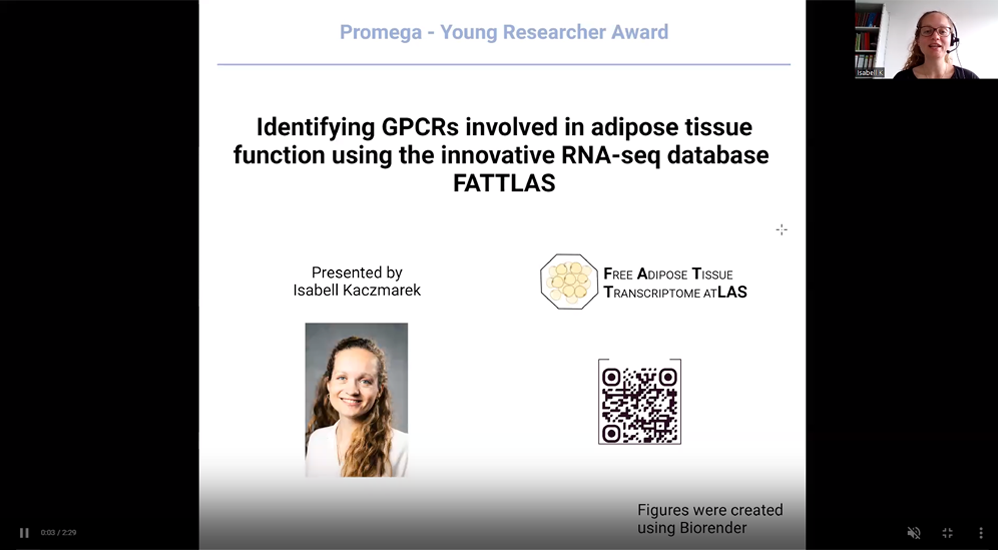Isabell Kaczmarek
Rudolf Schönheimer Institute for Biochemistry
University of Leipzig
GPCR in (patho)physiology
Help me to win the Young Researcher
Award 2023 from Promega.
Why should you vote for me!
Working in an interdisciplinary field, I am combining bioinformatic studies with wetlab experiments. Using a top-down approach I identify genes involved in adipose tissue (patho)physiology via RNA-seq data before I characterize them in depth. To simplify the analysis of RNA-seq data not only for me but for the global research community, I implemented an open access database, called FATTLAS, which incorporates publicly available RNA-seq datasets of adipocytes and adipose tissue. Thus, my research work increases the usability of transcritpomic data to all scientists around the world.
Abstract
The worldwide increasing prevalence of obesity is a major risk factor for severe health problems such as diabetes mellitus type 2, cardiovascular disease, and neurodegeneration. Therefore, understanding adipose tissue (AT) and adipocyte function is required to intervene not only in obesity progression but also in its onset. G protein-coupled receptors (GPCRs) and their signal transduction pathways are known to modulate AT and adipocyte function. Although it is well established that GPCRs are widely expressed in AT, their repertoire, regulation, and function in (patho) physiological conditions (e.g., obesity) is not fully resolved.

Previously, I identified four hitherto unrecognized GPCR, namely MAS Regulated GPR Family Member F (Mrgprf), Gpr146, Frizzled Class Receptor 5 (Fzd5), and Prostaglandin E Receptor 2 (Ptger2) being either regulated in obesity or highly expressed in adipose tissue using publicly available RNA-seq data. Analyzing the signal transduction of these GPCRs in HEK293T and their function in adipocytes using the (pre)adipocyte cell line 3T3-L1 reveals their role in AT function and helps to better understand AT (patho)physiology.For the identification of constitutive and stimulated G protein coupling of the four receptors, cAMP accumulation and NanoBRET were measured in a heterologous expression system using HEK293T. Subsequently, siRNA-mediated receptor knockdown in 3T3-L1 was used to clarify their physiological relevance in (pre)adipocytes regarding adipogenesis, cell viability, lipolysis, and adipokine secretion using the 3T3-L1 (pre)adipocytes.
Analyzing G protein coupling in HEK293T, I detected constitutive and PGE2/Taprenepag stimulated Gs coupling of PTGER2 as well as basal activation of Gi signaling by GPR146. MRGPRF and FZD5 did not show activation of G protein signaling. Furthermore, I found all receptors to be involved in adipogenesis. In addition, I identified MRGPRF to be essential for adipocyte viability and to regulate intracellular cAMP levels in 3T3-L1 cells. The constitutive activation of Gi protein signaling by orphan GPR146 appears to modulate adipocyte lipolysis, while FZD5 and PTGER2 did not affect the analyzed adipocyte.
Describe the activity of your laboratory in a few lines:
In my working group we are analyzing the role of G protein coupled receptors (GPCRs) in (patho)physiology. Especially, we are focusing on the identification and characterization of orphan GPCRs in adipose tissue and in pancreas. (Image)

Can you describe yourself in 3 adjectives?
Enthusiastic, committed, resourceful
Tell us something about your scientific background :
During my masters studies in the field of biochemistry I already gained interest in the (patho)physiology of adipose tissue (AT) working on a serine protease inhibitor in brown AT. After starting my PhD, I focused on the identification and characterization of G protein-coupled receptors hitherto unrecognized in AT function. Revealing their role in AT solely by using wetlab experiments quickly proved to be very difficult. Thus, I started to use bioinformatics to simplify these investigations using a top-down approach.
If you were a famous scientist, who would you be?
As I started my PhD, I gained interest into bioinformatics and started to analyze diverse publicly available RNA-seq datasets. Thereby, I found various, great publications written by M. Madan Babu, which analyze gene expression regulation. Since his work always inspires me, I would choose to be him.
What are your other interests outside of science?
Besides working in the lab, you can either find me at concerts or doing sports, like hiking, cycling or swimming.